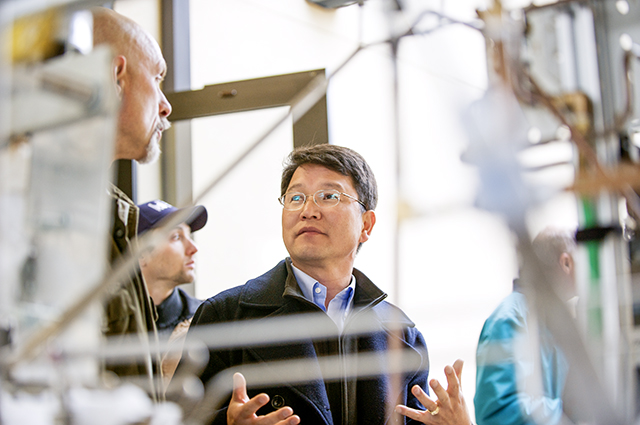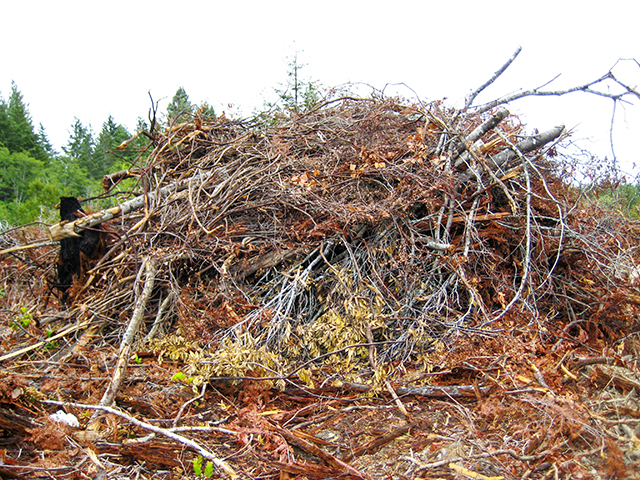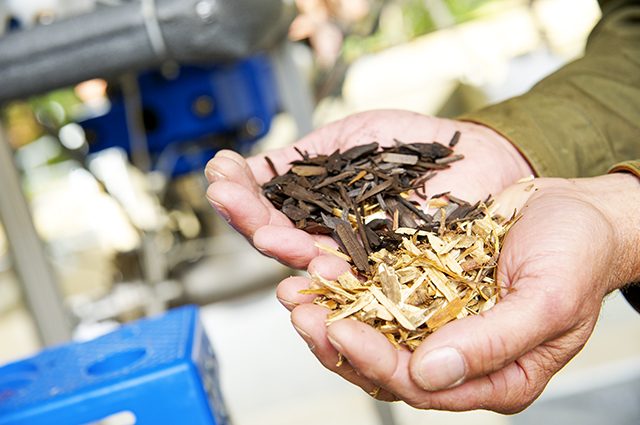
The grant is part of the Biomass Research and Development Initiative, a collaborative effort between the Department of Energy and the U.S. Department of Agriculture that supports renewable energy research in the rural United States. It is one of the largest grants ever received by HSU.
Under the grant, a team of academics, industry partners and forestland managers led by HSU Forestry Professor Han-Sup Han will build on existing research on the conversion of forest residues into renewable fuel and other valuable bio-based products. Forest residues refers to limbs, treetops and other waste materials left on the forest floor after timber harvesting, which are not effectively utilized but can potentially be a major source of bioenergy. Utilization of woody biomass has the potential to reduce U.S. dependence on foreign oil, lower greenhouse gas emissions and promote economic development in rural parts of the United States.
The grant will allow research teams comprising investigators, graduate students, postdoctoral researchers, and private sector partners to address technical challenges and make bioenergy technologies more marketable. The three research areas will be feedstock (processed forest residues) supply, mobile conversion technologies, and economic life-cycle analysis.

The feedstock supply group will be led by Han, the lead principal investigator on the grant. Han’s group will focus on the economics of converting forest residue into high-quality feedstocks. Researchers will conduct experiments and develop biomass recovery systems that improve the economics, accessibility, and production of quality feedstocks from forest residues.
“Some of the major barriers to utilizing forest residues are related to the high cost of collecting, processing, and transporting feedstock to conversion locations.” Han says. “This study will take innovative approaches that cost-effectively handle forest residues and produce quality feedstocks in the woods. Furthermore, removing forest residues helps reduce fire risk, supports forest restoration efforts, and prepares for planting trees.”
The mobile conversion technologies group, led by Arne Jacobson, director of HSU’s Schatz Energy Research Center, will study biomass conversion technologies that convert slash or wood chips into biomass fuels and products at or near collection sites in the forest. Methods will include:
• gasification to produce biochar,
• pyrolysis to produce torrefied pellets, and
• densification to produce briquettes.
“Due to the high cost of collection and transportation, woody biomass is a promising but widely untapped source of renewable energy,” says Jacobson. “One of the goals of our research is to investigate mobile biomass conversion technologies, which will reduce the cost associated with the transportation of woody biomass and increase the value of processed products by converting forest residue at or near field collection sites.”

Ted Bilek, an economist with the USDA Forest Service, will lead the economic life-cycle analysis group. Bilek’s team will perform economic analyses and conduct a life-cycle analysis documenting the economic benefits and other environmental effects related to utilizing forest residues.
“It’s not enough that the technologies work and produce energy,” Bilek says. “They also need to be economically viable, socially acceptable, and environmentally sustainable. These are the focuses of our group. Our research will also help to highlight areas that offer the greatest potentials to improve returns and to ensure long-term sustainability.”
The grant is titled Waste to Wisdom: Utilizing forest residues for the production of bioenergy and bioproducts. Research partners include: Green Diamond Resource Company, the University of Washington, Oregon State University, the Bureau of Land Management, USDA Forest Service, USFS Rocky Mountain Research Station, USFS Forest Products Lab, Redwood Forest Foundation, Forest Concepts LLC, Steve Morris Logging, Peterson Pacific Corp., Biochar Solutions Inc., Pellet Fuels Institute and the Forest Business Network LLC.
HSU will host a Biomass Research & Development Initiative kick-off meeting May 13-14. The two-day event will include remarks by elected officials, Department of Energy representatives and university officials, as well as tours of campus research facilities and a biomass recovery operation at Green Diamond Resource Company. The media is invited to attend. For a full agenda, or to RSVP, contact Joel Bisson at jab22@humboldt.edu.
A Leader in Biomass Research
Humboldt State is a recognized leader in biomass research. Since 2008, HSU researchers have undertaken 18 grant-funded biomass projects. Over the past five years, SERC has been involved in a number of biomass energy conversion projects, including projects focused on biomass gasification and torrefaction. For more information, visit schatzlab.org or now.humboldt.edu.